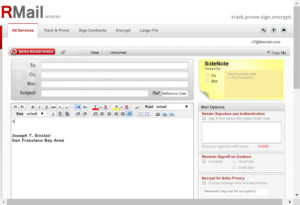
RMail Web is not a complete email service. RMail Web simply enables you to use RMail services with your current email service provider and email address. Note that plug-ins (extensions) for Outlook, Hotmail, and Gmail are available from RMail and for IBM Notes and Salesforce from those companies.
For instance, suppose your email service provider is XYZ.com and your email address is JudyLipton@XYZ.com. You use Mozilla Thunderbird as your email program for which there is not an RMail plug-in available. How do you use the RMail services?
First, you can’t use RMail services in your email program (Thunderbird) because there is no RMail plug-in for it. But you can gain access to the RMail services via your browser. You can use your RMail Web account by bookmarking RMail.RPost.com (classic design) or app.RMail.com (new design), the addresses of the RMail Web login pages.
Think of RMail Web as an alternative compose page when you need to send secure email. The From address is your normal From address.
Once you’ve logged in, you use the RMail Web email program. (Note that the RMail Web email program is different than the RMail Inbox email program.) You use this RMail Web email program just as you would use any other email program, noting that it includes all the RMail services built-in for your convenient use. But when the recipient receives one of your emails, it will show it as coming from JudyLipton@XYZ.com.
Keep in mind, however, that this is a one-way street. In other words, using RMail Web you can only send email messages, not receive them. You receive your replies and other email messages in your normal email program, such as Thunderbird in this example.
How Does It Work?
So, how does this work? Well, you use your normal email program for sending and receiving routine email messages. When you want to use an RMail service, you go to your browser, click (tap) on your RMail Web bookmark, and log in. Then use the RMail Web email program. By doing this you can send email (using your normal email address) using any of the RMail services. Again, you can’t receive messages in the RMail Web email program; you receive replies and other messages in your normal program.
This procedure is almost as convenient as having a plug-in for your email program. All the messages that you send from your normal email program will appear listed as sent mail in your normal email program; the messages that you send from the RMail Web program, however, will not appear as sent messages in your normal email program. And RMail Web itself does not store (archive) the email messages you send using RMail Web. But you don’t ever want to be without a copy of what you sent. What can you do to keep track of the RMail Web email messages you send?
Conveniently, there is a checkbox in the RMail Web email program that enables you to automatically send a copy to yourself of what you sent to the recipient. Put a check in the checkbox, and whatever you send using the RMail Web email program you will also receive a copy in your normal email program. Should you elect not to send a copy to yourself, you will have no record of what you sent.
This might be a little confusing, but all you need to remember is that RMail Web just sends email using RMail services via your browser. It doesn’t receive any email.
RMail Web and RMail Inbox Keep in mind that RMail Web is just a convenient add-on in contrast to the RMail Inbox secure email service that is a complete email service (together with a robust email program) and a system in which you have your own @RMail.com email address. RMail Web has its own logins and password.
Is RMail Web a secure email system? Yes. Your RMail Web email via your browser automatically encrypts your messages between your RMail Web email program and the RMail Web email server, even when you don’t use any of the services. But when you send a copy of a message to yourself (for record-keeping purposes), it goes from the RMail Web email server to your normal email server unencrypted (assuming your normal email service is not a secure email service). In such a case, the RMail Web system is not a secure email system unless you elect to send the message with Message-Level encryption.
More Secure The use of RMail Web is more secure if you use a secure email service as your normal email service. Of course, if you use RMail Inbox as your secure email service, you don’t need RMail Web.
What About Those Plug-ins?
There are plug-ins for Gmail, Microsoft Office 365, Outlook, Outlook.com, Hotmail, Zimbra, Groupwise, SAP, Salesforce, IBM Notes, and other email software. For some email software the plug-in simply puts a button in your email program. The button displays a menu of RMail services. It just makes using RMail Web more convenient. For other email software, RMail is integrated into the software itself without the one-way limitation of RMail Web.